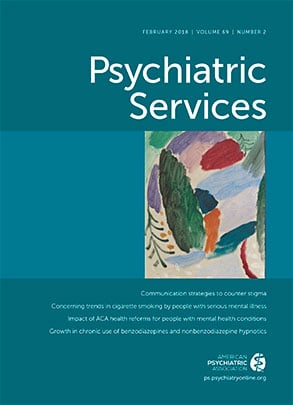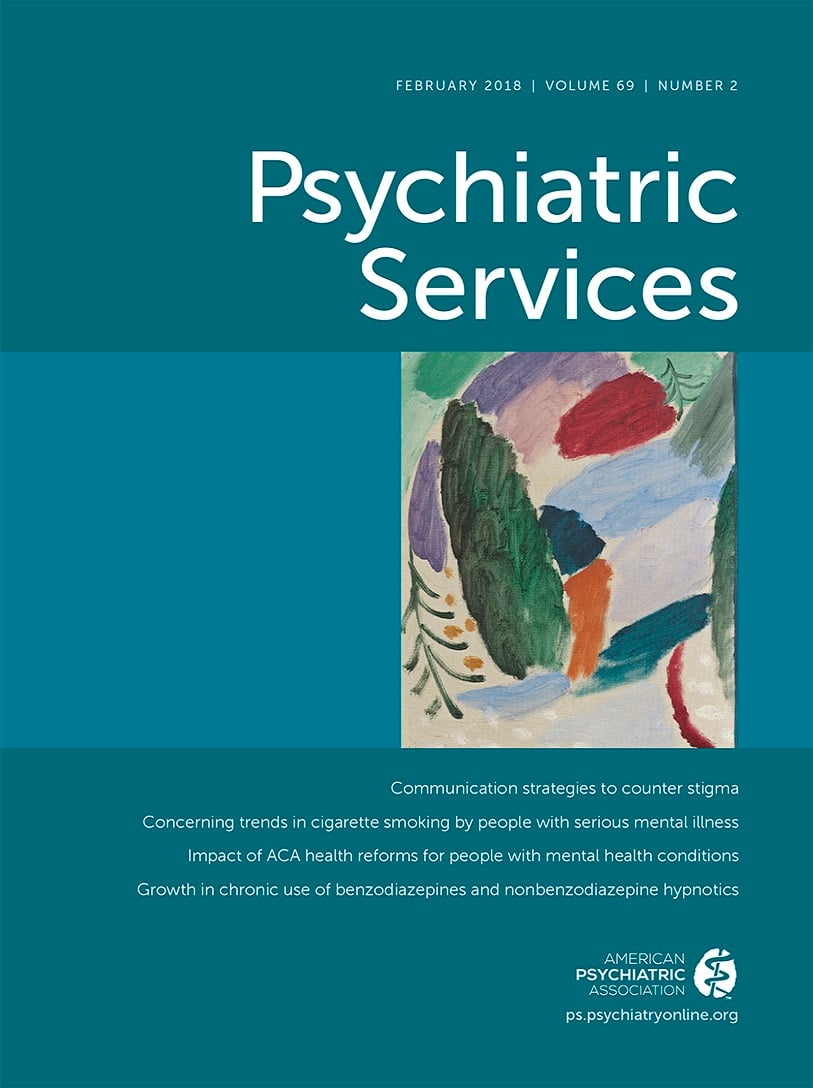Clozapine is the most effective antipsychotic for patients with treatment-resistant schizophrenia (
1). Treatment guidelines recommend that clozapine be given to all eligible patients who have not responded after two antipsychotic trials (
2). Clozapine is also approved by the U.S. Food and Drug Administration (FDA) for treatment of suicidality and has a variety of off-label uses. Data on clozapine’s cost-effectiveness are growing—two recent publications tout significant cost savings associated with clozapine use (
3,
4).
Despite the overwhelming evidence of clozapine’s superiority for some patients and its availability in generic form, clozapine is prescribed infrequently in the United States. Only six states report that more than 10% of Medicaid-eligible patients with schizophrenia have received a prescription of clozapine (
5). Data also suggest that many individuals who are eligible for clozapine have been inadequately treated for years, undergoing multiple trials that have proven ineffective (
6). Underutilization contributes to suboptimal care, and it increases costs.
A wide variety of barriers, both clinical and administrative, contribute to the underuse of clozapine, but few large-scale studies have examined this issue. The barriers include provider, patient, and family issues; resource availability; health system factors; and administrative burdens. In recent years, efforts to increase and optimize clozapine use are starting to improve use (
7). This Open Forum briefly describes a national ongoing effort to address the underutilization of clozapine.
Methods of Work Group Development
The National Association of State Mental Health Program Directors (NASMHPD) initiated a national work group to identify barriers to clozapine underutilization and undertake an effort to address these barriers at a national level. The initial work group included 11 clinicians and researchers who met one or two times monthly from March 2016 to September 2016. The group listened to and discussed a number of presentations on clozapine; identified existing literature on the subject, including recent physician survey data on clozapine underutilization in Maryland (
8); and identified a list of barriers to clozapine use. After identifying barriers, the work group developed recommendations focused on specific stakeholder groups. The recommendations were vetted at the following four venues: within the network of the NASMHPD, by the Substance Abuse and Mental Health Services Administration (SAMHSA), by mental health commissioners during a meeting in Washington, D.C., and during a national Webinar of state mental health networks. Feedback from these groups was incorporated into the white paper so that all voices had opportunity for input. These recommendations were published online in September 2016 (
9). The work group acknowledges that the recommendations are general in nature and may not adequately address every barrier.
In order to continue the work begun by the work group and develop specific solutions in line with selected recommendations, NASMHPD convened a larger group subsequent to the release of the white paper. Comprised of members from the expanded group, two separate work groups are now focusing on national advocacy and dissemination efforts for the clozapine recommendations and clozapine centers-of-excellence models. The work group is also considering incorporating other initiatives, such as recent SAMHSA-funded work to develop training materials for use of clozapine. SAMHSA representatives have participated in both work groups to ensure that the projects are moving in parallel and to help identify gaps and needs. SAMHSA also sponsored a clozapine centers-of-excellence meeting in September 2017 to plan the next steps. Authors of the white paper and some additional work group members will be presenting an invited forum at the Institute of Psychiatric Services in October 2017.
Barriers to Appropriate Clozapine Use
Although many barriers to clozapine use exist, the group focused initially on 14 barriers. In this Open Forum, we discuss selected barriers contributing to clozapine’s underutilization.
Medical risks and side effects.
Medical risks and adverse events associated with clozapine contribute to clozapine’s underutilization. Common risks and side effects include hypersalivation, tachycardia, enuresis, sweating, eosinophilia, metabolic syndrome, and constipation. Among the more serious medical risks of clozapine are myocarditis and cardiomyopathy, seizures, complications of constipation, and severe neutropenia. Severe neutropenia risk has led the FDA to mandate regular blood draws to monitor the absolute neutrophil count. The risk of severe neutropenia is .05% to .86% (
9); however, clinicians fear the risk of this side effect, despite its low incidence, and overestimate its incidence.
Prescriber knowledge and comfort around the decision to use clozapine also remain significant barriers to care. Lack of training and experience are notable barriers. Prescribers overestimate patients’ unhappiness with many side effects (
10).
Administrative burden and registry.
The requirements to prescribe, dispense, and receive clozapine are incorporated into a single, shared program called the clozapine risk evaluation and mitigation strategy (REMS). Clozapine REMS has replaced the earlier registries run by each individual manufacturer of clozapine with a single registry with new procedures and requirements. The administrative complexities of the previous patient registries and the REMS present additional obstacles to the initiation and use of clozapine. In particular, use of the clozapine REMS has proven cumbersome for many providers, made interdisciplinary collaboration more difficult by separating the ability of team members to view past labs, introduced additional education requirements for providers, and eliminated functionality that was present in the older clozapine registries. Complying with the clozapine REMS has proven particularly problematic when patients undergo transitions in care, such as inpatient admission.
Lack of centralized resources.
Many treatment systems and practices lack a centralized infrastructure for coordinating the array of services required by persons receiving clozapine. These may include family and patient education, laboratory facilities, medical consultation, adherence monitoring, and service coordination. Although specialized clozapine clinics or programs have proven useful, there are few resources available to develop and implement these specialized and often interdisciplinary programs.
Frequent blood draws and concern for adherence to blood draw protocols are often cited as one of the most significant barriers to treatment (
8,
9). The risk of missed blood draws increases without case management or oversight from community treatment providers to help organize this endeavor. Point-of-care monitoring could reduce the need to coordinate filling prescriptions and prescriber appointments with laboratory visits. Challenges to point-of-care monitoring include challenges to obtaining a five-part white blood cell differential with capillary blood and lack of current Clinical Laboratory Improvement Amendments (CLIA) waivers for point-of-care measurement of blood for absolute neutrophil counts (ANC) outside of the laboratory, similar to waivers for blood glucose monitors.
Benign ethnic neutropenia treatment.
Clozapine utilization is lower among African-American patients than among Caucasian patients, with more frequent discontinuation and fewer starts (
11,
12). Benign ethnic neutropenia (BEN) may partially explain the low use and frequent discontinuation of clozapine in this group. BEN occurs among people of African or Middle Eastern ancestry. A subgroup of this population has low baseline ANCs before the start of clozapine and do not have an increased risk of severe neutropenia or infection (
13–
15). Furthermore, they are not at an increased risk for severe neutropenia despite lower baseline ANCs. New clozapine U.S. prescribing information and monitoring guidelines that went into effect in fall 2015 establish separate monitoring plans for BEN patients. The lack of a definition for BEN in product labeling and concern about using these lower ANC monitoring guidelines remain barriers to the use of clozapine in those with BEN.
Additional barriers.
The use of clozapine in corrections and forensic facilities is challenging because many correctional systems are independent of mental health systems and routine psychiatric care is often marginalized. The complexities of using clozapine, the scarcity of psychiatric services (including consultation) in some facilities, and the lack of research on clozapine use in correctional populations are further barriers to clozapine utilization in forensic settings.
Additional barriers to use of clozapine noted in the white paper include a lack of standardized materials for shared decision making; complex protocols for treatment monitoring and management of side effects; the need for consultative services, such as hotlines; formulary issues; and costs of ancillary services, such as transportation and service coordination. Finally, it is important to differentiate between the barriers that clinicians and administrators perceive and those that truly affect patients and their care. Perceptions that lead prescribers to avoid clozapine become real barriers when they affect practice.
Recommendations for Increasing Use of Clozapine
The NASHMPD Web site published 36 recommendations for expanding use of clozapine (
9). The recommendations were addressed to 10 key stakeholder groups, including prescribers of clozapine, psychiatric residency/fellowship programs, academic health centers, acute care and psychiatric hospitals, academic scientists and pharmaceutical research programs, local and state health authorities, payers, correctional systems, providers of continuing education for health professionals, federal agencies and national efforts, and developers of technology. Some recommendations are more easily addressed, and others may serve as goals for planning. Nonetheless, all are potential areas in which changes could influence care. Some highlighted recommendations include improving residency trainee standards, bringing together key stakeholders to improve the process of clozapine REMS, including clozapine in hospital and correctional facility formularies, and advancing technologies for point-of-care hematologic monitoring and sharing clinical information.
Conclusions
Clozapine is a superior medication for the patient with treatment-resistant schizophrenia. However, clozapine is underutilized because of a variety of barriers. This Open Forum describes a concerted attempt at the national level to improve clozapine use. The description of this effort is intended to encourage practitioners, administrators, researchers, families, patients, and local and state governments to serve as ambassadors to key stakeholder groups and advocate for the use of this evidence-based treatment. This effort is limited by the fact that it is not an official effort, is not supported by funding, and has been initially focused at the level of local and state health authorities. The process of vetting recommendations did not involve direct input from patients and families, but future endeavors will include patient and family involvement. This effort serves as an important first step to improving access to clozapine and overcoming barriers to its utilization. Expanded utilization of clozapine could benefit millions of patients while resulting in substantial cost savings to the entire health care system.
Acknowledgments
The authors thank Kathy Sanders, M.D., Andrew J. McLean, M.D., M.P.H., Dale K. Adair, M.D., Brian Hepburn, M.D., Brian Sims, M.D., Aaron J. Walker, M.P.A., Stuart Yael Gordon, J.D., Anita Everett, M.D., Robert O. Cotes, M.D., Kammarauche Asuzu, M.D., M.H.S., Frederick C. Nucifora, D.O., Ph.D., Mark Hurst, M.D., Krista Baker, L.C.P.C., and Keris Myrick, M.B.A., M.S., for their contributions to the National Work Group and recommendation development. They also thank individuals at SAMHSA and the NASMHPD and the mental health commissioners and teams at the state level for their feedback and edits to the process and final recommendations.

